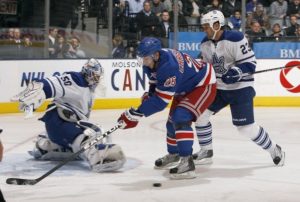 Quick note: Complications resulting from increased university work, my job and sickness have combined to prevent me from doing any articles recently. The good news is I should have that stuff figured out, so expect some larger team articles soon.
Quick note: Complications resulting from increased university work, my job and sickness have combined to prevent me from doing any articles recently. The good news is I should have that stuff figured out, so expect some larger team articles soon.
Brett Lebda came into Toronto with a lot of praise from current Leafs VP of Hockey Operations Dave Poulin. The praise came from a familiar place; Poulin was the head coach for the University of Notre Dame for 10 years, where he initially scouted and recruited Lebda for their program. Lebda later chose Detroit as his destination for pro hockey, staying in their system for seven years, of which five were spent with the Red Wings themselves. He lived under the shadow and tutelage of great defensemen such as Nicklas Lidstrom, Mathieu Schneider and Chris Chelios.
Having built his career in Detroit while winning a Stanley Cup in the process, Lebda seemed poised for a larger role on a developing team. I was not so convinced when he signed, stating on MLHS that Lebda is a bottom pairing defenseman and should be expected of nothing more. This by itself would not be a bad signing, but Lebda carries with him a two year contract worth $2.9 million. For that kind of money, more should be expected. With that said, let—s take a look at what some advanced metrics can tell us about Lebda—s effectiveness thus far for the Maple Leafs. We—ll begin by looking at his even strength statistics before moving on to special teams. All stats used in this article were obtained from BehindtheNet.ca.
Defense is a crucial component to forward success. Defensemen need to transition the puck from their own end into their opponents— end quickly and efficiently. This crucial cog in the offensive machine is relayed to us through CORSI numbers, which tracks shots directed at the opponents— goal (be they shots, missed shots or blocked shots) minus those directed at the player—s own goal while they—re on the ice. From this, a number is given to determine CORSI ranking. Lebda—s ranking while on the ice is 2.53, good for fifth of the eight defensemen that have played 10 or more games. Those below him are Komisarek, Schenn and Aulie. Komisarek is obviously not playing as well as he could, while Schenn and Aulie are still young players learning the ways of the NHL one step at a time. At 28 years of age, Lebda should have been a steadying presence for the transition game, but he—s been nothing of the sort.
More telling for Lebda—s CORSI is the team—s CORSI ranking when Lebda—s on the bench, which is 5.26. This is by far the highest on the team, meaning that the Maple Leafs direct many more shots toward the opponents— goal when Lebda is off ice. One stat that anyone could understand is perhaps the most sobering part to Lebda—s even strength offensive output: the team—s shooting percentage when Lebda is on the ice. At even strength, the Leafs have a shooting percentage of 0.00% when Lebda is on the ice. Not a single goal has been scored 5-on-5 while Lebda is playing. The second lowest is Keith Aulie at 3.85% and the highest is Francois Beauchemin at 7.93%. This is absolutely dreadful for a player that has already played 17 games this season.
Now we can take a look at some defensive statistics. We—ve established that 0 goals have been scored at even strength with Lebda on the ice, but 12 goals have been scored against the Maple Leafs when he—s on the ice. This brings him to a +/- of -3.38 for every 60 minutes of ice time he receives. This is obviously reflected in his -13 rating through only 17 games. This puts him at dead last for defensemen on the Maple Leafs, and tied for 254th in the NHL. Of note here is that the player he—s tied with (Ian White) and the four players below him (Henrik Tallinder, Sergei Gonchar, James Wisniewski and Andy Greene) have all played at least 11 games more than Lebda has. The second lowest +/- on the team is Francois Beauchemin at -7, a full six points ahead of Lebda.
So how about the save percentage of Giguere and Gustavsson while Lebda is on the ice at even strength? It comes down to a measly .888%. This is again the lowest on the team among defensemen that have played at least ten games. Beauchemin is second lowest at .890% and Tomas Kaberle is highest at .934%. This indicates that Lebda is giving opponents better position to shoot from. Better positions lead to a higher chance of a goal, so a defenseman that lets his opponent get to these areas frequently will cause a dip in a goaltender—s stats. Finally, Lebda draws 0.6 penalties for every 60 minutes of ice time while taking 0.8 himself in that span. That ranks him as second highest on the defense core in drawn penalties, but unfortunately also second in taken penalties, negating that positive effect.
Our final even strength analysis is in zone starts. These stats measure where a player starts a shift (offensive, neutral, defensive) and where they end it. This is quantified in OZONE%, or the percentage of shifts started in the offensive zone, and Fin OZONE%, or the percentage of shifts ended in the offensive zone. Unsurprisingly, Brett Lebda—s OZONE% is the highest on the team at a gargantuan 60.2%. Tomas Kaberle, the most productive offensive player on the Maple Leafs— back end, is second at 57.6%. This indicates that Ron Wilson is sheltering Lebda due to his prior defensive errors. Lebda—s shifts finish in the offensive zone only 48.8% of the time, a dramatic shift of -11.4%. This is again the highest disparity on the team, with the best being Carl Gunnarsson at +5.9%.
The powerplay is where Lebda earned his single point thus far this season, a secondary assist on a Grabovski goal. The team shooting percentage when Lebda is on for the powerplay is a miniscule 5.00%, with only Schenn—s 4.17% being lower. Save percentage is again where Lebda is lowest, running at a .750% rate on the powerplay. The second lowest is Schenn at .833%. Of course the OZONE% is quite high for all players on the back end, but Lebda finishes his powerplay shifts in the offensive zone only 60.0% of the time, with Phaneuf being the lone player lower at 56.5%. All of this despite getting an average of 1:38 in ice time on the powerplay per game, serving on the second unit. As for shorthanded stats, Lebda averages only 0:15 of shorthand ice time per game, so looking at those stats is an act of futility.
It—s fairly simple: nearing the midpoint of the 2010-11 season, Lebda has been a disaster. He—s already being frequently scratched despite just receiving a very lucrative contract from the Maple Leafs. He never played this poorly in Detroit. Was he being pulled up by the great players surrounding him, or is there a better player in there somewhere? For our sakes, I hope it—s the latter. Otherwise, it could be a very long 2 years when Lebda is on the ice.


![Jim Montgomery Post Game, Bruins 4 vs. Leafs 2: “[Marchand] still manages to get under people’s skin, yet he doesn’t cross the line” Jim Montgomery, Boston Bruins post game](https://mapleleafshotstove.com/wp-content/uploads/2024/04/jim-monty-pg-to-218x150.jpg)
























![Jim Montgomery Post Game, Bruins 4 vs. Leafs 2: “[Marchand] still manages to get under people’s skin, yet he doesn’t cross the line” Jim Montgomery, Boston Bruins post game](https://mapleleafshotstove.com/wp-content/uploads/2024/04/jim-monty-pg-to-100x70.jpg)






